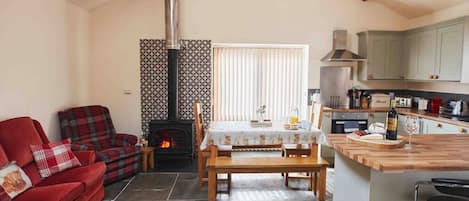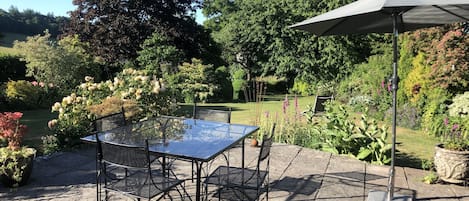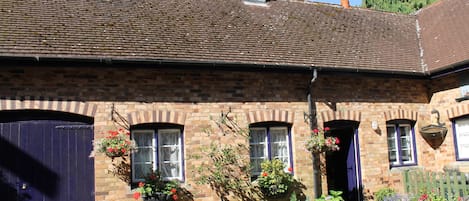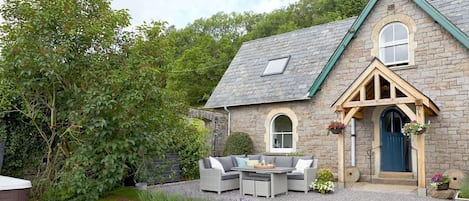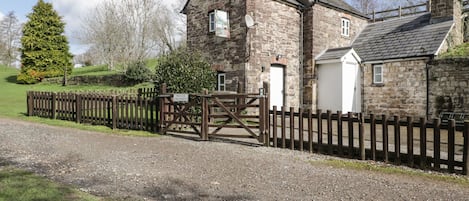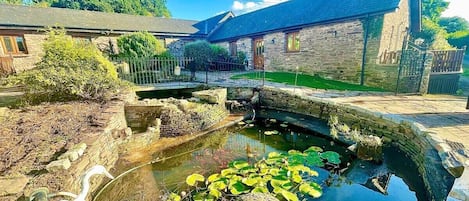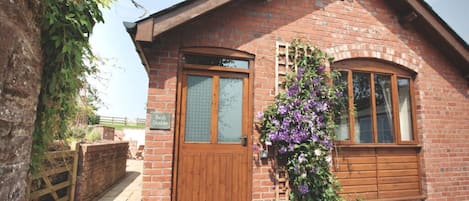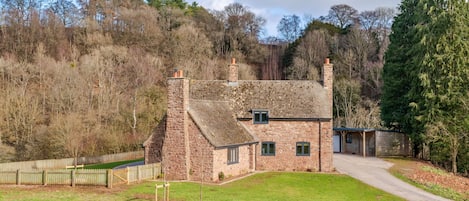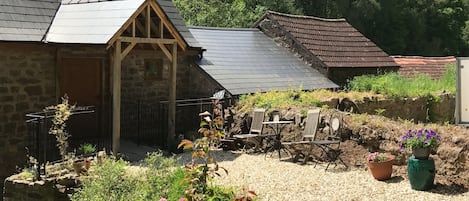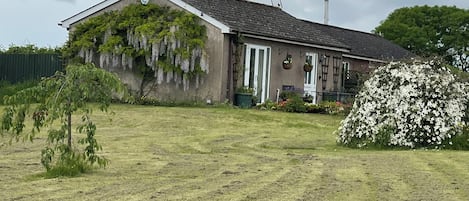Entire home
Detached ONE LEVEL stone barn
Photo gallery for Detached ONE LEVEL stone barn

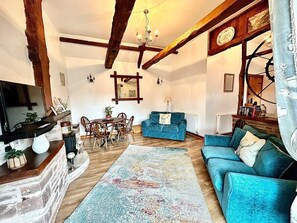
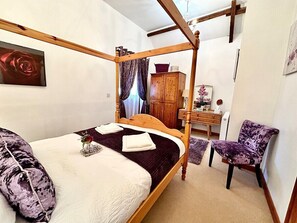
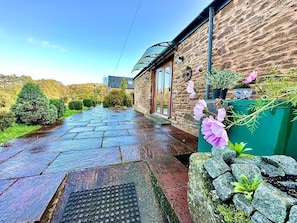

Reviews
10 out of 10
Exceptional
2 bedrooms2 bathroomsSleeps 4
Popular amenities
Explore the area
Monmouthshire, Wales
- Wye Valley13 min drive
- Chepstow Racecourse14 min drive
- Tintern Abbey20 min drive
- Bristol Filton Airport (FZO)51 min drive
Rooms & beds
2 bedrooms (sleeps 4)
2 bathrooms
Bathroom 1
Bathroom 2
Spaces
Kitchen
Balcony
Garden
About this property
Detached ONE LEVEL stone barn
You’ll have plenty to enjoy at this historic place in a picturesque setting.
The barn was originally part of a 16th Century 200 acre farm.
Lovingly restored only using stone and wood from the original structure and outbuildings including ancient farming machinery found in the grounds.
The barn is steeped in history yet has all modern creature comforts including fully equipped kitchen, great sized living space and 2 Ensuite bedrooms.
One being a twin and the other a double.
Rowan is a rural and semi secluded cosy detached stone built barn that once upon a time was a cow shed for The Pentre Farm on the grounds of which the barn sits and it now hosts one twin room and one double, both en suite, spacious sitting/dining room and with excellent views, from the lounge of the pond below and valley beyond.
The private patio has seating area and the barn also has a private drive and large gardens to front and side.
Llangwm Uchaf is best known for the Church of St. Jerome. The oldest parts of the church date from the 12th century, built in the Early English style. The church was partly rebuilt by J. P. Seddon in the 1860s.
The church contains a remarkable medieval rood screen and rood loft, c. 1500, restored during Seddon's 19th-century reconstruction. It has been described as a breathtaking sight, rising almost to the roof and one of the most spectacular rood screens in South Wales.
It has been suggested that the village's remoteness saved the screen from destruction by the Puritans.
An ancient structure ornamented with trellis-work, possibly a stoup, a lamp or a piscina, was found built into the wall during restoration. Three "Green Men" with foliage issuing from their mouths are carved in the chancel arch.
Buried in the chancel of the church, though no memorial to him survives, is Walter Cradock, the 17th-century cleric born at Trefela 1.5 miles (2.4 km) south of the church. He was inspired to become an Independent by fellow church Dissenter William Wroth.
Swansea University historian Dr Alun Withey has examined in some detail a 1671 dispute over the church seating arrangements. He reports that the village was ablaze, with diverse variances, quarrels and debates even lawsuits, to the utter destruction and overthrow of manie. It was left to the churchwarden, respected local yeoman farmer John Gwin, to settle matters. Gwin's notebook containing his seating plan still survives, giving us, Withey argues, a rare insight into the world of parochial life in 17th-century Wales, and thus contributes greatly to our general understanding of Welsh history.
The church is a Grade I listed building It has been declared redundant and is in the care of the Friends of Friendless Churches. It was repaired in 2013–2014.
Church of St. John
The parish has a smaller second church, that of St. John at Llangwm Isaf. This church is located on the route to the Church of St. Jerome and is also in the Early English style, restored in the 19th century.
Baptist chapel
The Baptist chapel, situated at the south west end of the village, was built in 1840 on land given by Cradock Gwynne Watkins of the village. The building was financed by the local Baptists who, at that time, attended "Peniel", an older (now ruined) chapel on Golden Hill of which the chapel at Llangwm was a branch.
The exterior is cement rendered with a slate roof. There are three windows, with tracery on each side wall. A date-stone for 1840 is set above a tall pointed door entrance. The interior has a gallery at the entrance end and late-19th-century pews. The walls are finished in plain two-tone and the pulpit has a plain balustraded rail around. There is seating for approximately 100 persons.
The chapel, which is mentioned in Sir Joseph Bradney's A History of Monmouthshire (1923), was designated a Grade II listed building on 12 October 2000.
Gaer Fawr hill fort
The Iron Age hill fort at Gaer Fawr (meaning in Welsh, "great fort"), about 1 mile (1.6 km) south-east of Llangwm Uchaf, is one of the largest hill forts in Monmouthshire, and commands wide views over the Vale of Usk to the west, north and east.
We have some fantastic walks through and around the village and the whole area is very popular with cyclists and dog walkers.
The villagers are incredibly friendly and will always offer a little bit of help if needed on directions and lovely places to see.
We have SUPERFAST WIFI and smart TV.
The barn was originally part of a 16th Century 200 acre farm.
Lovingly restored only using stone and wood from the original structure and outbuildings including ancient farming machinery found in the grounds.
The barn is steeped in history yet has all modern creature comforts including fully equipped kitchen, great sized living space and 2 Ensuite bedrooms.
One being a twin and the other a double.
Rowan is a rural and semi secluded cosy detached stone built barn that once upon a time was a cow shed for The Pentre Farm on the grounds of which the barn sits and it now hosts one twin room and one double, both en suite, spacious sitting/dining room and with excellent views, from the lounge of the pond below and valley beyond.
The private patio has seating area and the barn also has a private drive and large gardens to front and side.
Llangwm Uchaf is best known for the Church of St. Jerome. The oldest parts of the church date from the 12th century, built in the Early English style. The church was partly rebuilt by J. P. Seddon in the 1860s.
The church contains a remarkable medieval rood screen and rood loft, c. 1500, restored during Seddon's 19th-century reconstruction. It has been described as a breathtaking sight, rising almost to the roof and one of the most spectacular rood screens in South Wales.
It has been suggested that the village's remoteness saved the screen from destruction by the Puritans.
An ancient structure ornamented with trellis-work, possibly a stoup, a lamp or a piscina, was found built into the wall during restoration. Three "Green Men" with foliage issuing from their mouths are carved in the chancel arch.
Buried in the chancel of the church, though no memorial to him survives, is Walter Cradock, the 17th-century cleric born at Trefela 1.5 miles (2.4 km) south of the church. He was inspired to become an Independent by fellow church Dissenter William Wroth.
Swansea University historian Dr Alun Withey has examined in some detail a 1671 dispute over the church seating arrangements. He reports that the village was ablaze, with diverse variances, quarrels and debates even lawsuits, to the utter destruction and overthrow of manie. It was left to the churchwarden, respected local yeoman farmer John Gwin, to settle matters. Gwin's notebook containing his seating plan still survives, giving us, Withey argues, a rare insight into the world of parochial life in 17th-century Wales, and thus contributes greatly to our general understanding of Welsh history.
The church is a Grade I listed building It has been declared redundant and is in the care of the Friends of Friendless Churches. It was repaired in 2013–2014.
Church of St. John
The parish has a smaller second church, that of St. John at Llangwm Isaf. This church is located on the route to the Church of St. Jerome and is also in the Early English style, restored in the 19th century.
Baptist chapel
The Baptist chapel, situated at the south west end of the village, was built in 1840 on land given by Cradock Gwynne Watkins of the village. The building was financed by the local Baptists who, at that time, attended "Peniel", an older (now ruined) chapel on Golden Hill of which the chapel at Llangwm was a branch.
The exterior is cement rendered with a slate roof. There are three windows, with tracery on each side wall. A date-stone for 1840 is set above a tall pointed door entrance. The interior has a gallery at the entrance end and late-19th-century pews. The walls are finished in plain two-tone and the pulpit has a plain balustraded rail around. There is seating for approximately 100 persons.
The chapel, which is mentioned in Sir Joseph Bradney's A History of Monmouthshire (1923), was designated a Grade II listed building on 12 October 2000.
Gaer Fawr hill fort
The Iron Age hill fort at Gaer Fawr (meaning in Welsh, "great fort"), about 1 mile (1.6 km) south-east of Llangwm Uchaf, is one of the largest hill forts in Monmouthshire, and commands wide views over the Vale of Usk to the west, north and east.
We have some fantastic walks through and around the village and the whole area is very popular with cyclists and dog walkers.
The villagers are incredibly friendly and will always offer a little bit of help if needed on directions and lovely places to see.
We have SUPERFAST WIFI and smart TV.
Property manager
Cymru Holidays
Premier Host
Add dates for prices
Amenities
Kitchen
Washer
Outdoor space
Parking available
Have a question?
BetaGet instant answers with AI powered search of property information and reviews.
Similar properties

RURAL stone barn with Log Burner, tranquil setting
RURAL stone barn with Log Burner, tranquil setting
- Kitchen
- Washer
- Pet-friendly
- Outdoor space
9.0 out of 10, (4 reviews)
House Rules
Check in after 3:00 PM
Minimum age to rent: 18
Check out before 11:00 AM
Children
Children allowed: ages 0–17
Events
No events allowed
Pets
No pets allowed
Smoking
Smoking is not permitted
Important information
You need to know
Extra-person charges may apply and vary depending on property policy
Government-issued photo identification and a credit card, debit card or cash deposit may be required at check-in for incidental charges
Special requests are subject to availability upon check-in and may incur additional charges; special requests cannot be guaranteed
On-site parties or group events are strictly prohibited
About the area
Usk
Usk is home to Detached ONE LEVEL stone barn. Usk Castle and Raglan Castle are local landmarks, and some of the area's activities can be experienced at Parva Farm Vineyard and St. Pierre Country Club. Looking to enjoy an event or a game while in town? See what's happening at Wales National Velodrome or Newport Stadium.
Monmouthshire, Wales
What's nearby
- Usk Castle - 5 min drive - 5.4 km
- Celtic Manor Resort Golf Club - 12 min drive - 17.6 km
- Wye Valley - 13 min drive - 9.0 km
- Chepstow Racecourse - 14 min drive - 16.1 km
- Tintern Abbey - 20 min drive - 15.8 km
Getting around
Restaurants
- Groes Wen Inn - 20 min drive
- The Hall Inn - 7 min drive
- The Greyhound Inn - 10 min drive
- Sprokwobbles - 5 min drive
- Fountain Inn - 16 min drive
Frequently asked questions
Reviews
Reviews
No reviews yet
Be the first to leave a review for this property after your stay.
About the host
Hosted by Cymru Holidays
Premier Host
They consistently provide great experiences for their guests
Tell us how we can improve our siteShare feedback


